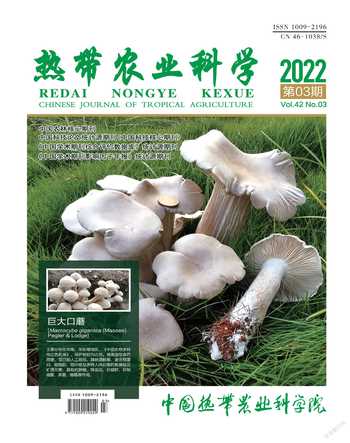四种捕食性瓢虫生殖系统观察
刘志伟 王永跃 黄丹青 毕可可




摘要 捕食性瓢蟲是生物防治中害虫的重要天敌,具有广阔的应用前景。为评价几种重要天敌瓢虫的生殖潜能,通过内部解剖观察了四斑小瓢虫Scymnus (Pullus) quadrillum、双麟弯叶毛瓢虫Nephus (Geminosipho) dilepismoides、淡色斧瓢虫Axinoscymnuscardilobus和广东食螨瓢虫Stethorus (Stethotus) cantonensis四种捕食性瓢虫的内生殖系统结构。结果显示,4种瓢虫雄性内生殖系统基本构成包括精巢、输精管、射精管、储精囊、附腺,淡色斧瓢虫、双麟弯叶毛瓢虫含2对附腺,广东食螨瓢虫和四斑小瓢虫附腺不明显;4种瓢虫的精巢形态和精巢管数量差异很大,四斑小瓢虫、双麟弯叶毛瓢虫、淡色斧瓢虫和广东食螨瓢虫每侧精巢管数量分别是5、5、2和1根。4种瓢虫雌性内生殖系统基本构成包括卵巢、侧输卵管、中输卵管、生殖腔、受精囊,四斑小瓢虫、双麟弯叶毛瓢虫、淡色斧瓢虫和广东食螨瓢虫每侧卵巢管数量分别是5、6、2和2根,广东食螨瓢虫的受精囊极不明显,且侧输卵管直接连接生殖腔。
关键词 生物防治;瓢虫;生殖系统;卵巢;精巢
中图分类号 S476.2 文献标识码 A DOI:10.12008/j.issn.1009-2196.2022.03.016
Observation of Reproductive System of Four Species of Predacious Ladybirds
LIU Zhiwei1,2 WANG Yongyue1 HUANG Danqing1 BI Keke1
(1. Guangzhou Institute of Forestry and Landscape Architecture, Guangzhou, Guangdong 510405, China;2. Ministry of Education Engineering Research Center of Biological Control, South China Agricultural University, Guangzhou, Guangdong 510642, China)
Abstract Predacious ladybirds are important natural enemies of insect pests in biological control with a broad application prospect. In order to evaluate the fecundity of different species of ladybirds, the internal reproductive system of four species of ladybirds, i.e.Scymnus (Pullus) quadrillum, Nephus (Geminosipho) dilepismoides, Axinoscymnuscardilobus and Stethorus (Stethotus) cantonensis, were observed by dissection. The results showed that the male internal reproductive system of the four ladybird species included testis, vas deferens, ejaculatory ducts, seminal vesicle and paragonia glands. Two pairs of paragonia glands exist in A. Cardilobus and N. dilepismoides, but they are not obvious in the other species. The structure of testes and the number of testicular tubes of the four species of ladybirds are greatly different. The number of testicular tubes on each side of the testes of S.(Pullus) quadrillum, N.(Geminosipho) dilepismoides, A. cardilobus and S.(Stethotus) cantonensis is five, five, two and one. The female internal reproductive system of the four species of ladybirds consists of ovary, lateral oviduct, median oviduct, genital chamber and spermatheca. The number of ovarioles on each side of the ovary of S.(Pullus) quadrillum, N.(Geminosipho) dilepismoides, A. cardilobus and S.(Stethotus) cantonensis is five, six, two and two. For S. cantonensis the spermatheca is not obvious, and the lateral oviduct is directly connected to the genital chamber.
Keywords biological control; ladybird; reproductive system; ovary; testis
捕食性瓢虫是生物防治中害虫的重要天敌,主要以蚜虫、介壳虫、粉虱、叶螨等有害生物为食物来源,对农林害虫控制起着重要作用[1-2]。害虫天敌昆虫的人工繁殖是实现生物防治应用的关键,产卵是昆虫繁殖的基本过程,而生殖系统是决定产卵的生理基础[3]。卵巢是雌性生殖系统的重要组成部分,卵巢管数量受遗传、环境等因素影响,在种间甚至种内存在差异[3]。国内外学者对瓢虫生殖系统有诸多研究,其中一个方向是瓢虫生殖系统观察、生殖系统对繁殖力的影响,环境条件对生殖系统和繁殖力的影响[3]。如Túler等[4]發现,未交配与已经交配的Tenuisvalvaenotata(Mulsant)储精囊形态类似,但只有交配后的储精囊才可能出现分泌物; Maffei 等[5]观察到瓢虫Eriopisconnexa(Mulsant)雄成虫精巢由许多囊泡(follicles)组成,雌成虫每侧卵巢管数量为4根;Stathas等[6]阐述了Rhyzobiuslophanthae(Blaisdell)生殖系统结构,并指出雄成虫的精巢囊泡和雌成虫的卵巢管数量都是10;Romano 等[7]将瓢虫精子超微结构差异性引入群类系统学中;陈洁等[8]观察到异色瓢虫 Harmonia axyridis卵巢管数量在25~33根,并根据有无卵室和卵黄沉积情况将卵巢发育划分为4个等级;王宗舜等[9]发现,七星瓢虫Coccinellaseptempunctata每侧卵巢管数量平均46根,并推测卵巢管数量与产卵量相关;刘其权等[10]将小黑瓢虫卵巢发育划分为6个等级。
本研究以鞘翅目 Coleoptera 瓢虫科 Coccinellidae 昆虫四斑小瓢虫Scymnus(Pullus)quadrillum(Motschulsky)、双麟弯叶毛瓢虫Nephus(Geminosipho)dilepismoides(Pang et Pu)、广东食螨瓢虫Stethorus(Stethotus)cantonensis(Pang)和淡色斧瓢虫Axinoscymnuscardilobus(Ren et Pang)为研究对象,通过组织解剖,首次观察了以上4种捕食性瓢虫的内生殖系统,丰富瓢虫生殖系统结构多样性,以期进一步丰富瓢虫生殖系统知识。
1 材料与方法
1.1 材料
供试瓢虫均采自广东省内,实验条件下[昼夜光照12∶12,温度(26±1)℃,湿度70%~75%],用豆蚜 Aphis craccivora饲喂四斑小瓢虫,双条拂粉蚧Ferrisia virgata(Cockerell)饲喂双麟弯叶毛瓢虫,朱砂叶螨Tetranychuscinnabarinus(Boisduval)饲喂广东食螨瓢虫,烟粉虱Bemisiatabaci(Gennadius)饲喂淡色斧瓢虫。用相应猎物饲养多代。
1.2 方法
1.2.1 解剖观察将羽化后1周的成虫用70%的酒精浸泡10 min,之后在滴有 Ring’s 生理盐水的点滴盘中进行解剖,每种瓢虫雌雄成虫各解剖30只,剔除生殖系统周围的组织,用生理盐水冲洗干净,最后将完整的生殖器置于体视镜( Zeiss,Stereo Discovery V2.0)下观察并拍照。 Ring’s 生理盐水的配制:先将氯化钠、氯化钾、磷酸二氢钠、碳酸氢钠分别溶解在少量蒸馏水中,并将氯化钙溶液逐滴加入到上述溶液中,边滴边搅拌,避免产生不溶解的磷酸钙沉淀;各组分比例:20%氯化钠,10%氯化钾,10%氯化钙,5%碳酸氢钠,1%磷酸二氢钠。
1.2.2 专业术语及缩写说明专业术语及缩写如下:气管( trachea,Tr);生殖腔(genital chamber, Gc)、生殖板(genital plate,Gp)、侧输卵管( lateral oviduct, Lo)、中输卵管( median oviduct, Mo)、卵巢管( ovary,Ov)、受精囊( spermatheca,Sp)、端丝( terminal filament,Tf)、射精管( ejaculatory duct,Ed)、弯管(phallus,P)、雄性附腺1(paragonia gland 1, Pg1)、雄性附腺2(paragonia gland 1, Pg2)、贮精囊( seminal vesicle,Sv)、精巢( testis, T )、阳基( tegmen,Te)、输精管( vas deferens,Vd)。
2 结果与分析
2.1 四斑小瓢虫内生殖系统结构
2.1.1 雌性生殖系统四斑小瓢虫雌性内生殖系统位于第2至第5腹节,包括1对卵巢、1对侧输卵管、中输卵管、受精囊、生殖腔。每侧卵巢含5根卵巢管,通过端丝束缚在一起,基部汇合于侧输卵管,2 根侧输卵管汇合于中输卵管,侧输卵管较中输卵管窄;中输卵管向下开口于生殖腔;受精囊位于生殖腔侧向顶端,角质化,红褐色,其下端可见深色角质化管状结构,生殖腔末端为生殖孔(图1-a )。
2.1.2 雄性生殖系统四斑小瓢虫雄性内生殖系统位于第3至第8腹节之间,包括1对精巢、1对输精管、射精管,未发现附腺。每个精巢由5个乳白色且半透明球形精巢管构成,内可见深色絮状物质。输精管和射精管都较长且弯曲,射精管连接弯管,弯管贯穿阳基(图1-b )。
2.2 双麟弯叶毛瓢虫内生殖系统结构
2.2.1 雌性生殖系统双麟弯叶毛瓢虫雌性内生殖系统位于第4至第8腹节,包括1对卵巢、1对侧输卵管、中输卵管、受精囊、生殖腔。每侧卵巢含6根卵巢管,所有卵巢管通过端丝束缚在一起,2根侧输卵管汇合于中输卵管;侧输卵管比较短,中输卵管向下开口于生殖腔;受精囊角质化,红褐色,通过受精囊导管与生殖腔连通(图2-a)。
2.2.2 雄性生殖系统双麟弯叶毛瓢虫雄性内生殖系统位于第3至第5腹节,包括1对精巢、1对贮精囊、1对输精管、2对附腺、射精管。每个精巢由5个半透明乳白色球状精巢管构成,似梅花形状。贮精囊在输精管基部。附腺不长,第2附腺比第1附腺宽,但比第1附腺薄,边缘锯齿状,2 对附腺可见稀疏散布着的白色圆点。射精管较短,弯曲幅度小,比较平滑,与弯管相接,弯管贯穿阳基中部(图2-b )。
2.3 淡色斧瓢虫内生殖系统结构
2.3.1 雌性生殖系统淡色斧瓢虫雌性内生殖系统位于第2至第6腹节,包括1对卵巢、中输卵管、受精囊、生殖腔。每侧卵巢含2根紧密贴合的卵巢管,端丝不明显,无侧输卵管,卵巢管直接与中输卵管相連,中输卵管很短,开口于生殖腔,生殖腔较长且宽大。受精囊位于中输卵管侧顶端,小且角质化,颜色很淡,2片生殖板较宽,边缘平滑(图3-a )。
2.3.2 雄性生殖系统淡色斧瓢虫雄性内生殖系统包括1对精巢、1对输精管、1对贮精囊、2对附腺、射精管。每侧精巢由2个长管状精巢管构成,半透明状。贮精囊位于输精管基部,这两部分构成较长的管状结构。与第1附腺相比,第2附腺较长且粗,不透明度加深。射精管较短,弯曲幅度小,较为平滑,与弯管相连(图3-b )。
2.4 广东食螨瓢虫内生殖系统结构
2.4.1 雌性生殖系统广东食螨瓢虫雌性内生殖系统位于第2至第6腹节,仅包括1对卵巢、1 对侧输卵管、生殖腔。每侧卵巢含2根卵巢管,基部与侧输卵管相连,中输卵管与生殖腔界限不明显,生殖腔宽大,2 个卵巢独立分开,分别位于生殖腔两侧,无受精囊,生殖孔位于生殖腔末端,较宽大,生殖板很小,末端较平滑(图4-a)。
2.4.2 雄性生殖系统广东食螨瓢虫雄性内生殖系统位于第3至6腹节,包括1对精巢、输精管、贮精囊、射精管。每侧精巢仅由1个方形的乳白色精巢管构成,内部分布白色圆形组织。输精管很短或不明显,射精管基部膨大形成贮精囊,与精巢管很相似,但无类似于精巢管内部的白色圆形组织。与贮精囊相连的小段射精管弯曲幅度较大,向后延伸渐宽,之后又逐渐收缩变细,呈现中间宽大、两端细小的形态,其末端与弯管相连(图4-b )。
3 讨论与结论
种间雄性内生殖系统结构差异很大。四斑小瓢虫和双麟弯叶毛瓢虫的每侧精巢有5个球状精巢管,这与瓢虫EriopisconnexaMulsant[5]和Rbyzobiuslopbantae Blaisdell[6]很相似。广东食螨瓢虫每侧精巢仅1个块状精巢管,淡色斧瓢虫每侧精巢由2个长管状精巢管构成。瓢虫精巢形态和构成呈现多样化,推测构成精巢的囊泡数量与虫体大小相关。
Hodek[11]研究结果表明,已报道的鞘翅目、双翅目、蜉蝣目、半翅目、膜翅目、鳞翅目和毛翅目等68种昆虫种内体型大小和体重与卵巢管数量呈正相关[11],寄蝇Trichopodagiacomellii和天牛Semanotusjaponicus也符合这种规律[12-13]。 Richards[14]对拟熊蜂属Psithyrus中的几个种类进行研究时发现,不管是种间还是种内,体型大的个体比体型小的个体拥有更多卵巢管,如Psithy- rusfernaldae、Psithyrusinsularis等。在瓢虫种间,体型大小和体重与卵巢管数量呈正相关[3];这种现象也存在于瓢虫种内,如体重31 mg 的七星瓢虫卵巢管数量比体重24 mg 的个体多了59根[15]。本研究中的4种瓢虫体型较小,淡色斧瓢虫、双麟弯叶毛瓢虫、广东食螨瓢虫、四斑小瓢虫体长分别为1.5~1.6 mm,1.4 mm,1.3~1.5 mm,1.5~1.8 mm[1],其单侧卵巢管数量分别是2、6、2和5 根。因此,这4种瓢虫的卵巢管数量与其对应的体型大小可能是生物学上的适应性进化。
产卵量是昆虫繁殖能力的一个重要表现,即产卵量越多,意味着繁殖能力越大[16]。卵巢管是产卵量的主导因素,即卵巢管数量越多,通常产卵量越大[3,15]。Taylor 等[17]对Romaleamicroptera进行研究时提出,遗传变异和发育条件决定了卵巢管数量。但是,昆虫卵巢管数量并非固定不变,其受到多种因素影响,如基因决定的细胞程序性死亡、猎物类型、季节变化、食物丰富度等[18-21],且并非所有卵巢管都能发育成熟,在食物有限条件下,优先满足部分卵巢管[22]。另外,取食条件薄弱,伴随衰老和频繁交配,可能是导致瓢虫产卵量逐渐减少的原因[23]。取食不同猎物也是影响产卵的重要因素,取食烟粉虱的六斑月瓢虫Menochilussexmaculates(Fabricius)平均单雌产卵量157.67粒,而取食玉米蚜的群体平均单雌产卵量达798.77粒[24]。昆虫种内体型大小也与产卵量呈正相关[11],即产卵量随体型增大有增加的趋势,这种现象在天牛科的Monochamusurussovii[25]和Semanotus japonicas[13]也得到证实。本研究中的4种捕食性瓢虫均在适宜环境和充足食物的条件下饲养,其体型都较小,且单侧卵巢管数量比较少,淡色斧瓢虫、双麟弯叶毛瓢虫、广东食螨瓢虫、四斑小瓢虫分别是2、6、2和5根,可能会限制产卵量。因此,在瓢虫人工繁育过程中,应根据瓢虫特异性最适环境,创造良好的繁育条件;在生物防治应用中,不宜单独使用双麟弯叶毛瓢虫、四斑小瓢虫、广东食螨瓢虫和淡色斧瓢虫作为害虫天敌昆虫,应综合应用多种方法,以期达到理想的防治目的。
参考文献
[1] 任顺祥, 王兴民, 庞虹, 等.中国瓢虫原色图鉴[M].北京:科学出版社, 2009:2-19.
[2] 王兴民, 陈晓胜, 邱宝利, 等.捕食性瓢虫采集与调查取样技术[J].应用昆虫学报, 2014, 51(5):1362-1366.
[3] Hodek I, Emden H F V, Honek A. Ecology and behaviourof the ladybird beetles (Coccinellidae) [M]. Oxford, UK: Wiley- Blackwell, 2012, 57-97.
[4] Túler AC, Silva-Torres CSA, Teixeira VW, et al. Histologyof the spermateca and stored sperm of Tenuisvalvaenotata (Coleoptera: Coccinellidae): Reproductive apparatus in coc- cinellids[J]. Physiological Entomology, 2018, 43 (3):180-187.
[5] Maffei E M D, Fragoso D D B, Pompolo S D G, et al. Mor-phological and cytogenetical studies on the female and male reproductive organs of EriopisconnexaMulsant (Coleoptera, Polyphaga, Coccinellidae)[J]. Netherlands Journal of Zool- ogy, 2001,51(4):483-496.
[6] Stathas G J, Eliopoulos P A, Kontodimas D C, et al. Adultmorphology and life cycle under constant temperatures of the predator Rhyzobiuslophanthae Blaisdell (Col., Coccinelli- dae)[J]. Anzeiger für Schädlingskunde, 2002,75(4):105-109.
[7] Romano D, José L N, Glenda D, et al. Fine structure of theladybird spermatozoa (Insecta, Coleoptera, Coccinellidae)[J]. Arthropod Structure & Development, 2018, 47(3):286-298.
[8] 陳洁, 吴春娟, 张青文, 等.异色瓢虫卵巢发育及卵子发生过程观察[J].植物保护学报, 2015, 42(2):237-243.
[9] 王宗舜 , 钟香臣 , 仇序佳 , 等. 七星瓢虫生殖的观察[J].昆虫学报, 1977, 20(4):397-404.
[10] 刘其全, 孙莉, 徐桂萍, 等.小黑瓢虫生殖系统的解剖观察[J].福建农林大学学报(自然科学版), 2010, 39(5):460-464.
[11] Hodek A. Intraspecific variation in body size and fecundityin insects: a general relationsh[J]. Oikos, 1993, 66:483-492.
[12] Coombs M T. Influence of adult food deprivation and bodysize on fecundity and longevity of Trichopodagiacomellii: A South American parasitoid of Nezaraviridula[J]. Biological Control, 1997, 8(2):119-123.
[13] Togashia K and Togashia L. Body size dependency of ovari-ole number and timing of reproductive maturation in Se- manotus japonicus (Coleoptera: Cerambycidae)[J]. Journal of Forest Research, 2017, 22(1):2-7.
[14] Richards K W. Ovarian development, ovariole number, and
relationship to body size in psithyrus spp.(Hymenoptera: Apidae) in Southern Alberta[J]. Journal of the Kansas Ento- mological Society, 1994, 67(2):156-168.
[15] Dixon A F G ,Guo Y. Egg and cluster-size in ladybird bee-tles(coleoptera: coccinellidae): The direct and indirect effects of aphid abundance[J]. European Journalof Entomology, 1993, 90:457-463.
[16] Togashi K. Lifetime fecundity and female body size inParagleneafortunei (Coleoptera: Cerambycidae)[J]. Applied Entomology and Zoology, 2007, 42(4):549-556.
[17] Taylor B J, Whitman D W. A test of three hypotheses forovariole number determination in the grasshopper Romaleamicroptera [J]. Physiological Entomology, 2010, 35(3):214-221.
[18] Mpakou V E, Velentzas A D, Velentzas P D, et al. Pro-grammed cell death of the ovarian nurse cells during oogenesis of the ladybird beetle Adalia bipunctata (Coleop- tera: Coccinellidae)[J]. Development, Growth & Differentia-tion, 2011, 53(6):804-815.
[19] Ferrer A, Dixon A F G, Hemptinne J L. Prey preference of ladybird larvae and its impact on larval mortality, some life-history traits of adults and female fitness[J]. Bulletin of Insectology, 2008, 61:5-10.
[20] Rhamhalinghan M. Seasonal Variations in Ovariole Num-bers per Ovary in CoccinellaseptempunctataL.Coleoptera: Coccinellidae[J]. Proceedings of Indian National ScienceAcademy, 1986, 52(5):619-623.
[21] Ferrer A, Dixon AFG, Gibernau M, et al.Ovarian dynamicsand specialisation in ladybirds [J]. Ecological Entomology, 2010, 35(1):100-103.
[22] Osawa N. The effect of prey availability on ovarian devel-opment and oosorption in the ladybird beetle Harmonia axy- ridis (Coleoptera: Coccinellidae)[J]. European Journalof Entomology, 2005, 102(3):503-511.
[23] Prevolsek J, Williams T D. Individual variation and plasticityin egg size in multicolored Asian lady beetles (Harmo- niaaxyridis)[J]. Integrative and Comparative Biology,2006,46(1):238-238.
[24] Tang L D, Li F, Zhao H Y, et al. Influence of three preyspecies on the development and fecundity of MenochilussexmaculataFabricius[J]. Acta EcologicaSinica, 2017, 37(17):5765-5770.
[25] Togashia K, Yamashita H. Effects of female body size onlifetime fecundityof Monochamusurussovii (Coleoptera: Cerambycidae)[J]. Applied Entomology and Zoology, 2017,52:79-87.
(責任编辑 林海妹)

